A great deal has been written about diversity in the Civil Service in recent weeks (not least the Institute's own report on women and Whitehall since 1979). The latest figures, published today by the Office for National Statistics, show that the Civil Service - and Senior Civil Service - has become more diverse in terms of gender, ethnicity and disability since 2010. However, progress has stalled on increasing the representation of people with disabilities and from ethnic minority backgrounds.
With the Spending Review and further staff reductions approaching, there are challenges ahead:
- the Civil Service is getting older
- the percentage of civil servants in more senior grades is increasing, and in junior grades decreasing.
A higher percentage of the Senior Civil Service is female than ever before, but this does not reflect the gender balance across the Civil Service as a whole.
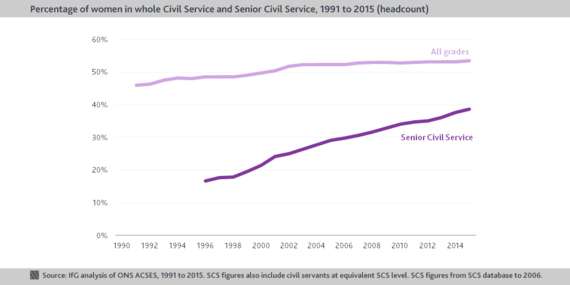
In 2015, 54% of civil servants in all grades were women. This has been reasonably steady for the past decade, with women having made up more than half of the Civil Service since the early 2000s. The percentage of women in the Senior Civil Service has increased from 35% in 2010 to 39% in 2015.
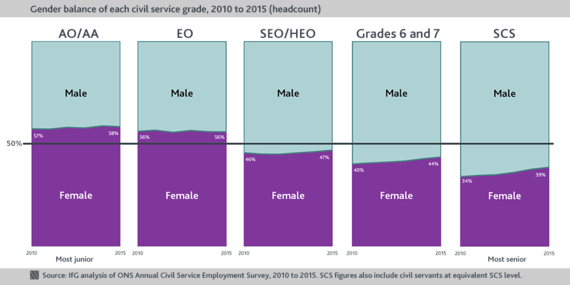
However, although there have been increases in female representation at SCS level, at grades 6 and 7 (now 44%, up from 40% in 2010), and Senior and Higher Executive Officer level (now 47%, up from 46% in 2010), men remain in the majority at these more senior grades. The opposite is true in the more junior grades - women outnumber men at Executive Officer level (56%) and Administrative Officer and Assistant level (58%). Despite the increase in the proportion of women at more senior levels, the gender balance at the top of the Civil Service does not reflect the gender balance of the service as a whole.
11% of civil servants identify as coming from an ethnic minority background, while 9% have a disability.
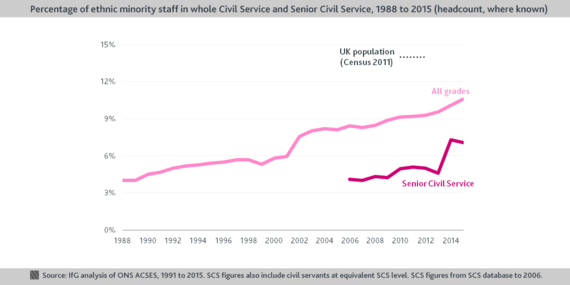
11% of the whole Civil Service was from an ethnic minority background in 2015, compared with 9% in 2010 and just 4% in 1988. This is still less than the proportion of the general UK population that is from an ethnic minority, which was 14% at the 2011 census. There is also a gap between the percentage of the whole Civil Service from an ethnic minority and that of the Senior Civil Service. At 7.1% in 2015, this is an increase on 5% in 2010, but progress on this front has slowed: a slightly higher percentage (7.3%) of the SCS was from an ethnic minority in 2014 than in 2015.
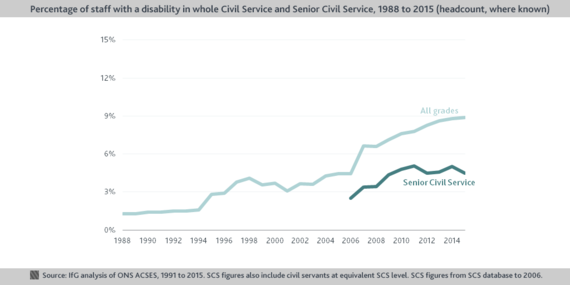
In 2015, about 9% of all civil servants have a disability. Again, this figure has risen since 2010 (when it was 5%); it has increased dramatically since 1988 (1%). And again, the percentage of senior civil servants with a disability is lower than across the Civil Service as a whole - 4.5% in 2015, down slightly from 5% in 2014.
Just 9% of civil servants are under 30, down from 14% in 2010.
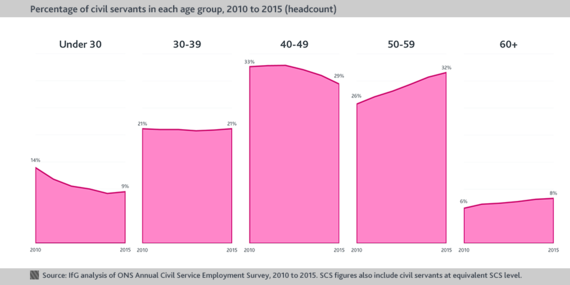
In 2010, 14% of all civil servants were under 30 - in 2015, just 9% were. Meanwhile, 26% of all civil servants were aged 50 to 59 in 2010 - 32% of them are in 2015. The percentage of the Civil Service aged 60 or over has also increased, from 6% to 8%. This reflects the recruitment freezes which were, according to the National Audit Office (NAO), largely responsible for the overall staff reductions since 2010, and which may have reduced the flow of younger people into the Civil Service.
A higher percentage of the Civil Service is in more senior grades than in 2010.
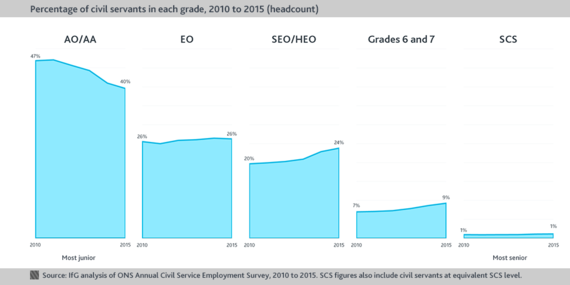
The percentage of people in senior grades has gone up since 2010. The number of civil servants in grades 6 and 7, the middle-management grades immediately below the Senior Civil Service, has increased from 36,630 to 39,530; they now make up 9% of the service, compared with 7% in 2010. Administrative officers (AO) and administrative assistants (AA), the most junior grades, accounted for 47% of the Civil Service in 2010 - they now account for 40%.
These trends again support the NAO analysis that, overall, staff reductions are the result of recruitment freezes rather than redundancies, with existing staff moving up through the grades and fewer people entering the organisation at its most junior levels.
London hosts the largest number of civil servants, but 82% of home civil servants are based outside the capital.
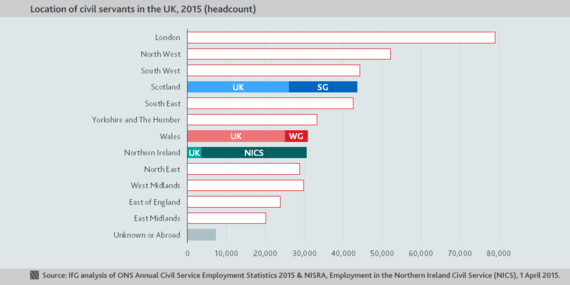
Almost 80,000 (79,020) civil servants were based in London in March 2015 - about 18% of the whole Civil Service (including the Welsh and Scottish governments, but not the Northern Irish Civil Service, which is not part of the home civil service). This is an increase from 16% in 2010.
Of the English regions the North West (12%), South West (10%) and South East (10%) are also home to significant parts of the Civil Service. The East Midlands hosts just over 20,000 civil servants, the smallest number in England, and 8,800 fewer than the North East (whose population is less than two-thirds the size).
In Scotland and Wales, UK government departments employ more civil servants than the devolved administrations. In Scotland, about 60% are employed by UK departments, including 40% of DfID's UK-based staff. In Wales, the percentage is higher: 81% of civil servants in Wales are working for the UK Government, including for the Wales-based DVLA and Companies House. In Northern Ireland, more civil servants are employed by the Northern Ireland Civil Service than by the UK Government; this reflects the devolution of certain areas, notably welfare.
Whitehall Monitor will explore some of these trends in more detail over the next few days.les are working for the UK Government, including for the Wales-based DVLA and Companies House. In Northern Ireland, more civil servants are employed by the Northern Ireland Civil Service than by the UK Government; this reflects the devolution of certain areas, notably welfare.
Whitehall Monitor will explore some of these trends in more detail over the next few days.